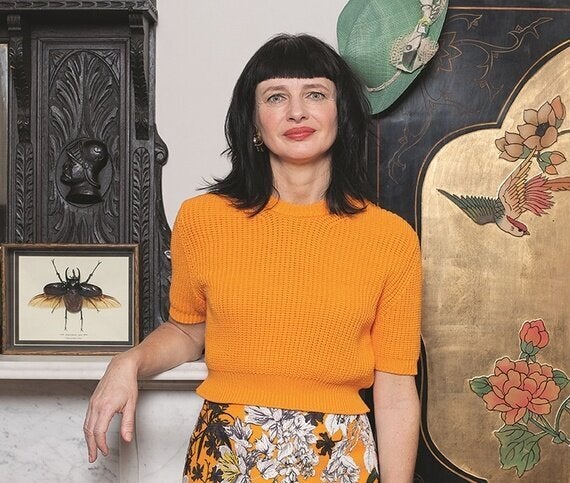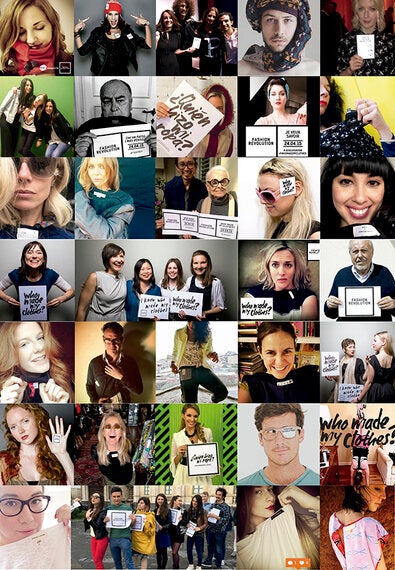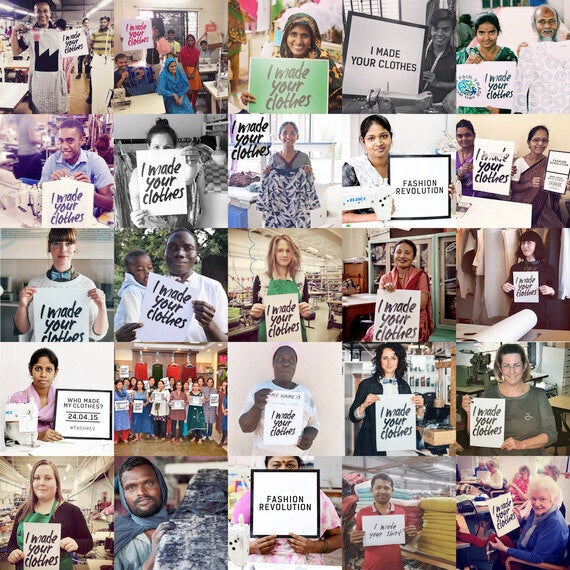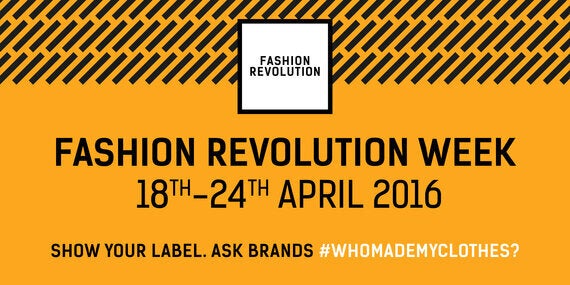
This week almost three years on from the devastating Rana Plaza complex collapse in Dhaka, Bangladesh, I managed to catch up with Carry Somers, to find out more about the Fashion Revolution that she has started and why she and many others are resolute in calling for change in the fashion industry.
Why did you decide to start Fashion Revolution and why do you think it is so important?
In the aftermath of the Rana Plaza collapse, everywhere I looked, there were newspaper articles calling for a more ethical fashion industry. The Rana Plaza catastrophe was a metaphorical call to arms. The idea for Fashion Revolution Day literally popped into my head in the bath a few days after the Rana Plaza disaster. It seemed like a good enough idea to act on, so I got out of my bath and immediately emailed the most obvious person I could think of, Orsola de Castro, co-founder of Estethica at London Fashion Week and co-founder of From Somewhere. The next morning, having received Orsola's enthusiastic response, Lucy Siegle, who writes the Ethical Living column for the Observer, phoned me and she was equally convinced that an annual Fashion Revolution Day was exactly what was needed to channel current concern into a longstanding campaign so that the victims of Rana Plaza and all the other tragedies that have occurred in the name of fashion will never be forgotten.
We believe 1134 is too many people to lose from the planet in one factory on one terrible day without that leading to revolutionary change in the fashion industry. The Rana Plaza was a metaphorical call to arms. That's when Fashion Revolution was born.

We are people from all around the world who make the fashion industry work. We are the people who wear clothes. And we are the people who make them. And we want to ignite a revolution to radically change the way our clothes are sourced, produced and purchased.
We have named the anniversary of the Rana Plaza disaster Fashion Revolution Day.
Fashion Revolution is now in its third year. Why have you decided to make Fashion Revolution a whole week this year instead of just one day?
This year, Fashion Revolution Day falls on a Sunday, so we have created Fashion Revolution Week: a week of activities around the world to demand a fairer, cleaner, more transparent and more beautiful fashion industry. We will have a different focus for each day, such as: Let's be Transparent: Looking at how brands are performing with supply chain transparency; How To Be a Fashion Revolutionary, with the launch of our #haulternative campaign and a focus on better ways to buy, wear and dispose of fashion; It's Time For a Fashion Revolution, with a focus on policy issues.

Do you think that Fashion revolution and the movement for a more ethical fashion industry is gathering momentum? Have you noticed a growing interest?
Most of the public is still not aware that human and environmental abuses are endemic across the fashion and textiles industry and that what they're wearing could have been made in an exploitative way. We don't want to wear that story anymore.
Fashion Revolution has already begun to spark a global conversation about the social and environmental issues facing the fashion industry. We have been been particularly successful over the past three years at engaging the public in these issues and giving them tangible ways to become part of the solution. We have created a How To Be A Fashion Revolutionary booklet this year which is full of inspiration and ideas about how we can all use our voices
and power to transform the fashion industry as we know it. We believe fashion can become a force for good.
Our main achievement has been in raising the awareness of fashion lovers worldwide. Our hashtag #whomademyclothes had 63 million reach and 124 million potential impacts on 24 April and we trended worldwide on Twitter on the day.
Fashion Revolution's press coverage for the year, as measured by Meltwater monitoring, was impressive to say the least. From April to December, we achieved 21.69 billion potential viewership, 8.5 billion of whom were unique users. April coverage included all major international publications such as The Diplomat, as well as fashion magazines, such as ID, Drapers, Grazia, Vogue and Marie Claire. Fashion Revolution was featured in TV broadcasts around the world, such as Fox News and CNN. Fashion Revolution founders both featured on prominent TV and radio broadcasting stations, such as BBC World Service which has a 210 million listeners and BBC World Business News, the most widely watched BBC channel with 75 million viewers.
Press coverage for our video 'The 2 Euro T-shirt: a Social Experiment' was also extensive. The video went viral (and was spread on social media by celebrities such as actor Ashton Kutcher and stylist Brian Boy) and has accumulated over 7 Million views to date. In June the video won the Bronze prize at the Cannes Lion Film Festival and this achievement was widely reported by international press. The follow up to the video has just been launched - The Child Labour Experiment.

Millions of people are calling for change and this is being widely reported around the world, with press coverage extending even beyond the 83 countries who form part of the Fashion Revolution movement. Ultimately brands will have to listen.
How do you think that Fashion Revolution is making a difference? Have you noticed any improvements in the ethics and supply chain transparency of high street shops?
The global fashion industry is opaque, exploitative and environmentally damaging and desperately needs revolutionary change. We are seeing high street brands and retailers start to become more transparent, but slowly. Too slowly.
Very few brands and retailers are publicly disclosing a list of their suppliers. Most fashion companies now monitor and audit the factories they work with directly. However, very few publish the results of that monitoring and auditing, information that would provide an insight into what their factories really look like. A few brands have received a lot of public pressure to publish information about their suppliers and some have responded by disclosing parts of it. Yet, the rest of the industry remains very opaque. None of the largest luxury brands (e.g. brands like Chanel, Stella McCartney, Louis Vuitton and Dior), of which many are grouped under the same owner (e.g. Kering, LVMH, Gucci), disclose the name or location of their suppliers.
And many brands and retailers can't disclose this information as they simply don't know where their clothes are made. Who Made My Clothes should be a simple question, but Behind the Barcode Fashion Report published last year found that 48% of brands hadn't traced the first tier CMT factories where their garments were made, 75% didn't know where
their fabrics and other inputs came from and 91% didn't know where the raw materials came from. Cotton harvested using forced labour in Uzbekistan is routinely labelled Made in Bangladesh and it was recently reported that Islamic State has taken over ¾ of the cotton fields in Syria. How do we as consumers know that we aren't supporting ISIS or slave labour with the next cotton garment we buy?
Together with Ethical Consumer, we are working on a Transparency Index, assessing 40 of the top selling brands in the UK, most of which are well-known global brands. The Index will be published for Fashion Revolution Week. We will look at different elements of transparency, including policy and commitment; tracking and traceability; social and environmental audits and remediation; and engagement and collaboration with other supply chain initiatives. The aim of the transparency ranking will is to benchmark fashion brands on their supply chain transparency and to encourage the adoption of best practice. We have also published our first White Paper setting out what sort of changes we expect to see, and what we're asking the industry and other stakeholders to do about it.
Beyond the high street, Fashion Revolution participated in high level EU, G7, UN and COP21 events last year. We co-organised events at the European Parliament, House of Commons, House of Lords and beyond.
We have begun to see governments and policymakers in the EU and beyond start to address transparency and sustainability over the past twelve months. We are certain this issue will remain on the policy agenda due to the launch of the European Commission's Garment Initiative in Spring 2016, on which we will be collaborating as a key stakeholder. The scope of this should also be extended to cover the entire garment, textile and fashion product value chain: from farmers to artisans and workers right through to end consumers.
What advice would you give to someone who would like to start shop more ethically for their clothes?
We launched the Haulternative last year, with YouTube vloggers including Noodlerella, CutiePieMarzia, Shameless Maya and Bip Ling. It's about how you can do a different kind of haul. A way of refreshing your wardrobe without buying new clothes, from upcycling to swaps to finding gems in charity shops. We call it the #haulternative. We had almost 2 million views of the #haulternative videos online last year. This year, we are asking fashion lovers from all over the world to join in and create their own haulternative video. We have 8 different haulternatives to choose from, so pick the one you like best: Love Story, Broken but Beautiful, Fashion Fix, Second Hand, Swap, DIY, Vintage or Hire. We hope that making a #haulternative video will inspire people with new ways of buying and experiencing clothes. Your voice can help us to change the world, one outfit at a time.
What will you be wearing for Fashion Revolution week? Please tell us about a few of the brands that you will be wearing and the people behind them?
I've just come back from Mexico and have bought myself some beautiful, embroidered vintage huipiles and some handwoven tops, direct from the weavers. In the UK, I'm a big fan of vintage fairs, especially the Clerkenwell Vintage Fair. If I buy new, I buy as an investment. I would rather spend more money and buy something which will last me for the next ten years. When I buy new, I often go to designer sample sales. I'm a big Pringle fan and all of the clothes I have purchased from them have been Made in Italy.
I also share most of my clothes with my daughter Sienna as well, so we will swap several items in our wardrobes when she comes back from University during the holidays. You can check out the video here.
Pachacuti has a shop in Ashbourne, Derbyshire where, alongside our Panama hat brand, we sell clothing by sustainable brands, with a strong focus on British-made accessories. Today I'm wearing a dress from the new Spring collection by Ruth Erotokritou stocked at Pachacuti. The collection is knitted in-house at her workshop in Greece.
Which event are you most looking forward to for Fashion Revolution this year?
Undoubtedly Fashion Question Time at the Houses of Parliament on 18th April. It was a fascinating event last year - the podcast and transcript are still online here.
As well as being founder of Fashion Revolution, you also have your own Fair Trade brand, Pachacuti. Please tell us a bit more about how you keep the connection between maker and wearer for your Panama hats?
I no longer work at Pachacuti - I have been full time at Fashion Revolution for the past two years. My husband, Mark Rogers now runs the brand. He has just returned from visiting our women's groups in the highlands of Ecuador and our straw harvesters and straw processing cooperative on the coast. He took a film crew with him and a short film about Pachacuti's transparent supply chain will be launched during Fashion Revolution Week.
Fashion Revolution will take place from 18th - 24th April 2016. To find out more about how you can get involved, visit fashionrevolution.org or follow
